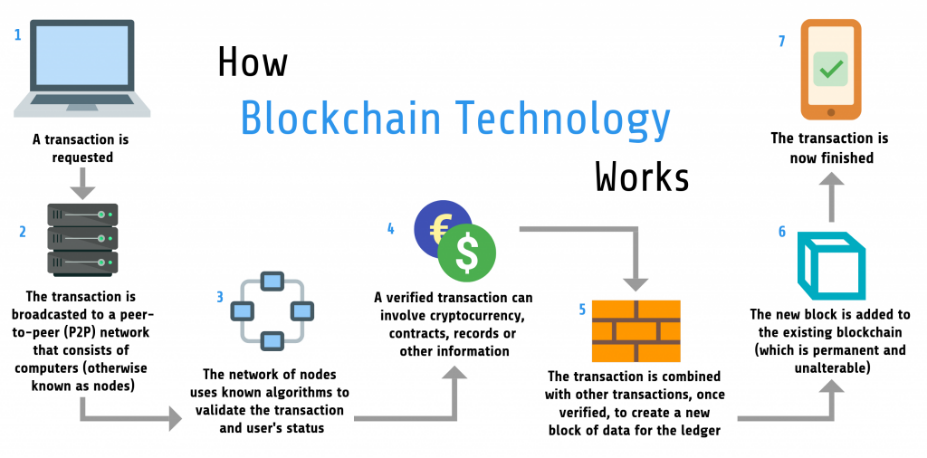
Blockchain Technology: A Complete Understanding
Here is a complete overall understanding of blockchain technology, a revolutionary concept that has the potential to reshape various industries. Imagine a digital ledger, decentralized and transparent, where every transaction is permanently recorded and secured through cryptography. This is the essence of blockchain technology, a system that empowers trust and efficiency in a world increasingly reliant on digital interactions.
Blockchain technology, a groundbreaking innovation, has emerged as a game-changer across diverse sectors. It’s a distributed ledger that maintains a secure and transparent record of transactions, transforming how we think about data management, security, and trust. This technology is built on the principles of decentralization, immutability, and transparency, ensuring that data is verifiable, tamper-proof, and accessible to all participants in the network.
Key Components of a Blockchain
A blockchain is a revolutionary technology that underpins cryptocurrencies and a growing number of other applications. It’s a distributed ledger that records transactions in a secure and transparent manner. Understanding the key components of a blockchain is crucial to grasping its functionality and potential.
Blocks
Blocks are the fundamental building blocks of a blockchain. Each block contains a collection of transactions that have been verified and bundled together. These transactions can represent anything from cryptocurrency transfers to data updates.
- Each block contains a timestamp, a hash of the previous block, and a set of transactions.
- The hash of the previous block creates a chain of blocks, linking them together in chronological order.
- This linkage ensures that any alteration to a block would be immediately apparent, as it would invalidate the hash of the subsequent block.
Adding New Blocks
New blocks are added to the blockchain through a process known as mining. Miners, who are essentially computers running specialized software, compete to solve complex mathematical problems.
- The first miner to solve the problem gets to add the next block to the chain and is rewarded with cryptocurrency.
- This process is called Proof-of-Work (PoW) and is designed to secure the blockchain by making it extremely difficult to tamper with.
- Once a block is added to the chain, it becomes immutable, meaning it cannot be changed or deleted.
Distributed Ledger
A blockchain is a distributed ledger, meaning that a copy of the entire transaction history is stored across multiple computers or nodes in a network. This distributed nature ensures that the blockchain is highly resilient to attacks and failures.
- Each node in the network has a complete copy of the blockchain.
- Every transaction is validated and added to the blockchain by multiple nodes, ensuring consensus and accuracy.
- The distributed nature of the ledger makes it extremely difficult for any single entity to manipulate the data.
Cryptographic Hashing, Here is a complete overall understanding of blockchain technology
Cryptographic hashing plays a crucial role in securing blockchain transactions. Each block and transaction is assigned a unique hash, a digital fingerprint generated through a complex mathematical function.
While I’m fascinated by the potential of blockchain technology, I’m also a bit distracted by the latest news – it seems like everyone’s talking about forget twitter this musk is into toe curling yumminess. But hey, that’s just a little bit of internet gossip, right?
Anyway, back to blockchain – the decentralized nature of this technology is truly revolutionary, and I can’t wait to see how it impacts the future.
- Any alteration to a block or transaction would result in a different hash, immediately alerting the network to a potential tampering attempt.
- Hashing also ensures the anonymity of users, as only their public keys are visible on the blockchain.
- Cryptographic hashing is a fundamental principle that underpins the security and immutability of blockchain technology.
Types of Blockchains
Blockchains are not all the same. They can be classified into different types based on their permissioning model, which determines who can participate in the network and how transactions are validated. The three main types of blockchains are public, private, and consortium.
Public Blockchains
Public blockchains are open to anyone and allow anyone to participate in the network. This means that anyone can join the network, download a copy of the blockchain, and participate in the validation of transactions.
- Advantages:
- Transparency: All transactions are publicly visible on the blockchain, making it difficult for anyone to manipulate or alter data.
- Security: Public blockchains are highly secure due to their decentralized nature and the use of cryptography.
- Immutability: Once a transaction is recorded on a public blockchain, it cannot be reversed or deleted.
- Accessibility: Anyone can join the network and participate in the validation of transactions.
- Disadvantages:
- Scalability: Public blockchains can be slow and expensive to use, especially during peak times.
- Privacy: All transactions are publicly visible on the blockchain, which can be a concern for privacy-sensitive applications.
- Complexity: Public blockchains can be complex to understand and use.
Public blockchains are the most common type of blockchain and are used for a variety of applications, including cryptocurrencies, supply chain management, and voting systems.
- Examples: Bitcoin, Ethereum, Hyperledger Fabric
Private Blockchains
Private blockchains are controlled by a single entity or organization. They are not open to the public and only authorized users can participate in the network.
- Advantages:
- Control: The owner of the private blockchain has complete control over the network, including who can join and how transactions are validated.
- Performance: Private blockchains can be faster and more efficient than public blockchains because they are not subject to the same level of congestion.
- Privacy: Transactions on a private blockchain are not publicly visible, which can be beneficial for privacy-sensitive applications.
- Customization: Private blockchains can be customized to meet the specific needs of the organization.
- Disadvantages:
- Centralization: Private blockchains are centralized, which means they are susceptible to the same vulnerabilities as traditional databases.
- Transparency: Transactions on a private blockchain are not publicly visible, which can be a concern for transparency and accountability.
- Limited Participation: Only authorized users can participate in the network, which can limit innovation and collaboration.
Private blockchains are often used for internal applications within organizations, such as supply chain management, data sharing, and identity management.
- Examples: Hyperledger Fabric, R3 Corda, Quorum
Consortium Blockchains
Consortium blockchains are a hybrid of public and private blockchains. They are controlled by a group of organizations, but they are also open to a limited number of participants.
- Advantages:
- Collaboration: Consortium blockchains allow organizations to collaborate and share data securely.
- Control: The consortium has control over the network, including who can join and how transactions are validated.
- Performance: Consortium blockchains can be faster and more efficient than public blockchains because they are not subject to the same level of congestion.
- Privacy: Transactions on a consortium blockchain are not publicly visible, which can be beneficial for privacy-sensitive applications.
- Disadvantages:
- Governance: Consortium blockchains can be complex to govern, as all members must agree on changes to the network.
- Trust: Consortium blockchains rely on trust between the participating organizations.
- Limited Participation: Only authorized organizations can participate in the network, which can limit innovation and collaboration.
Consortium blockchains are often used for industry-specific applications, such as supply chain management, healthcare, and financial services.
Understanding blockchain technology is like peeling back layers of an onion. It’s complex, but ultimately about security and transparency. It’s interesting to think how these concepts apply to the world outside tech, like how tuberculosis is the oldest pandemic and poverty makes it continue , a problem that requires transparency in healthcare and secure access to resources.
The same principles of trustless systems that drive blockchain could potentially be applied to address global health challenges, making the world a safer place for everyone.
- Examples: Hyperledger Fabric, R3 Corda, Corda
Consensus Mechanisms: Here Is A Complete Overall Understanding Of Blockchain Technology

A blockchain’s core function is to maintain a secure and immutable record of transactions. This is achieved through a process known as consensus, where all participating nodes in the network agree on the validity of the transaction history. Consensus mechanisms are algorithms that facilitate this agreement, ensuring the integrity and security of the blockchain.
Proof-of-Work (PoW) and Proof-of-Stake (PoS)
PoW and PoS are the two most prevalent consensus mechanisms, each with its unique characteristics and trade-offs.
Proof-of-Work (PoW)
PoW is the original consensus mechanism used by Bitcoin. It relies on miners, who are nodes in the network, solving complex mathematical problems to add new blocks to the blockchain. The first miner to solve the problem receives a reward in the form of cryptocurrency.
This process requires significant computational power, which consumes a lot of energy.
PoW is often compared to a lottery, where miners compete to solve a difficult problem and the winner gets a reward.
Proof-of-Stake (PoS)
PoS is a more energy-efficient alternative to PoW. Instead of relying on computational power, PoS uses a system where validators stake their cryptocurrency to participate in the consensus process. Validators are selected randomly based on the amount of cryptocurrency they stake, and they are responsible for verifying and adding new blocks to the blockchain.
PoS is often compared to a democratic election, where validators are elected based on the amount of cryptocurrency they stake.
Understanding blockchain technology is essential in today’s digital world, as it’s the backbone of cryptocurrencies and decentralized applications. It’s a complex system, but one that’s becoming increasingly relevant in our daily lives. Speaking of complex systems, the recent news of tv stations taking down inflammatory GOP ads about North Carolina’s Democratic senate candidate Cheri Beasley highlights the importance of accurate information in a digital age.
Just like blockchain technology, ensuring transparency and truthfulness in the digital sphere is crucial for maintaining trust and fostering a healthy online environment.
Factors Influencing the Choice of Consensus Mechanism
The choice of a consensus mechanism is influenced by several factors, including:
- Security:PoW is generally considered more secure than PoS, as it is more difficult for a single entity to control a majority of the network’s hash rate. However, PoS can be more secure in certain scenarios, such as when the network is already large and decentralized.
- Energy Efficiency:PoS is significantly more energy-efficient than PoW, as it does not require the same level of computational power.
- Scalability:PoS can potentially be more scalable than PoW, as it does not require the same level of network bandwidth.
- Decentralization:PoW can be more decentralized than PoS, as it is more difficult for a single entity to control a majority of the network’s hash rate. However, PoS can also be decentralized, depending on the design of the system.
Other Consensus Mechanisms
While PoW and PoS are the most popular, other consensus mechanisms are being explored, such as:
- Proof-of-Authority (PoA):PoA relies on a pre-selected set of validators who are known and trusted by the network. This mechanism is often used in private blockchains where security is paramount.
- Proof-of-Elapsed Time (PoET):PoET is a consensus mechanism that relies on a random selection of nodes to propose blocks, based on a pre-defined time interval.
- Proof-of-Spacetime (PoST):PoST is a relatively new consensus mechanism that uses a combination of storage space and time to secure the network.
Blockchain Applications

Blockchain technology has the potential to revolutionize various industries by providing secure, transparent, and efficient solutions. Its decentralized nature, immutability, and cryptographic security make it a suitable platform for a wide range of applications.
Applications Across Industries
Blockchain technology has the potential to disrupt various industries, offering solutions to existing challenges and creating new opportunities. Here are some key applications across different sectors:
Financial Services
- Cross-border Payments:Blockchain facilitates faster, cheaper, and more secure cross-border payments by eliminating intermediaries and reducing transaction fees.
- Digital Asset Management:Blockchain enables the secure and transparent management of digital assets, such as cryptocurrencies, securities, and intellectual property rights.
- Trade Finance:Blockchain streamlines trade finance processes by providing a shared and immutable record of transactions, reducing fraud and improving efficiency.
- Decentralized Finance (DeFi):Blockchain-based platforms offer decentralized financial services, such as lending, borrowing, and trading, without the need for traditional intermediaries.
Supply Chain Management
- Product Tracking and Traceability:Blockchain provides a transparent and auditable record of product origin, movement, and ownership, enabling better supply chain visibility and fraud prevention.
- Inventory Management:Blockchain simplifies inventory management by providing real-time data on stock levels, reducing waste and improving efficiency.
- Supply Chain Financing:Blockchain facilitates secure and efficient financing mechanisms for supply chain participants, improving cash flow and reducing risks.
Healthcare
- Electronic Health Records (EHRs):Blockchain enables secure and tamper-proof storage and sharing of patient medical records, improving data privacy and interoperability.
- Drug Supply Chain Management:Blockchain ensures the authenticity and safety of drugs by tracking their journey from manufacturing to distribution, preventing counterfeiting and adulteration.
- Clinical Trials:Blockchain facilitates secure and efficient data management for clinical trials, enabling faster research and development.
Government and Public Sector
- Digital Identity:Blockchain enables secure and verifiable digital identities, reducing identity theft and fraud.
- Voting Systems:Blockchain enhances the security and transparency of voting systems, preventing fraud and increasing voter confidence.
- Land Registry:Blockchain provides a secure and transparent platform for land ownership records, reducing fraud and improving efficiency.
Other Industries
- Gaming:Blockchain enables decentralized gaming platforms, providing fair and transparent gameplay, and allowing players to own in-game assets.
- Education:Blockchain can create secure and tamper-proof academic records, facilitating easier verification and sharing of credentials.
- Energy:Blockchain can facilitate peer-to-peer energy trading, enabling more efficient and sustainable energy markets.
Benefits of Blockchain Technology
- Transparency and Trust:Blockchain provides a transparent and auditable record of transactions, enhancing trust and accountability.
- Security:Cryptographic algorithms and consensus mechanisms ensure the security and integrity of data on the blockchain.
- Efficiency:Blockchain streamlines processes by eliminating intermediaries and reducing transaction costs.
- Immutability:Once a transaction is recorded on the blockchain, it cannot be altered or deleted, ensuring data integrity.
- Decentralization:Blockchain is decentralized, eliminating single points of failure and reducing the risk of censorship.
Challenges of Implementing Blockchain Technology
- Scalability:Blockchain networks can face scalability challenges, especially as adoption increases.
- Regulation:The lack of clear regulatory frameworks for blockchain technology can create uncertainty and hinder adoption.
- Complexity:Implementing blockchain technology can be complex, requiring specialized knowledge and technical expertise.
- Interoperability:Different blockchain platforms are often incompatible, creating challenges for interoperability.
- Energy Consumption:Some blockchain consensus mechanisms, such as Proof-of-Work, can consume significant energy.
Examples of Blockchain Applications
| Industry | Application | Benefits | Challenges |
|---|---|---|---|
| Financial Services | RippleNet for cross-border payments | Faster, cheaper, and more secure cross-border payments | Adoption by financial institutions and regulatory challenges |
| Supply Chain Management | Walmart’s blockchain platform for tracking food products | Improved product traceability and food safety | Integration with existing systems and data privacy concerns |
| Healthcare | MedRec for secure and tamper-proof storage of medical records | Enhanced patient privacy and data interoperability | Data privacy regulations and adoption by healthcare providers |
| Government | Estonia’s e-Residency program for secure digital identities | Improved identity management and access to digital services | Data security and privacy concerns |
| Gaming | CryptoKitties for decentralized ownership of digital assets | Fair and transparent gameplay and ownership of in-game assets | Scalability and regulatory challenges |
Blockchain Security

Blockchain technology is designed with inherent security features to ensure the integrity and immutability of data. This makes it a robust and reliable system for various applications.
Security Features of Blockchain
Blockchain’s security stems from a combination of features that work together to protect the network and its data.
- Cryptography:Blockchain uses advanced cryptographic techniques to secure transactions and data. Each block is encrypted using cryptographic hash functions, making it nearly impossible to alter or tamper with data once it’s recorded on the blockchain.
- Decentralization:Blockchain networks are decentralized, meaning there is no single point of failure or control. Data is distributed across multiple nodes, making it difficult for malicious actors to compromise the entire network.
- Immutability:Once a transaction is recorded on the blockchain, it becomes immutable. This means that the data cannot be altered or deleted, ensuring transparency and accountability.
- Consensus Mechanisms:Blockchain networks rely on consensus mechanisms to validate transactions and add new blocks to the chain. These mechanisms, like Proof-of-Work (PoW) or Proof-of-Stake (PoS), require a majority of nodes to agree on the validity of a transaction, making it difficult for malicious actors to manipulate the network.
Common Security Threats and Vulnerabilities
Despite its inherent security, blockchain systems are not immune to security threats.
- 51% Attack:A 51% attack occurs when a single entity or group controls more than 50% of the network’s computing power. This gives them the ability to double-spend coins, prevent transactions from being confirmed, and potentially even rewrite the blockchain’s history.
This threat is more significant in smaller or less established blockchains.
- Smart Contract Vulnerabilities:Smart contracts, which are programs stored on the blockchain, can be vulnerable to security flaws. These flaws can be exploited by malicious actors to steal funds or manipulate the contract’s logic.
- Key Management:Losing or compromising private keys can result in the loss of funds or control over assets stored on the blockchain. This is a critical security concern, and users must take appropriate measures to protect their private keys.
- DDoS Attacks:Distributed Denial of Service (DDoS) attacks can overwhelm a blockchain network with traffic, making it difficult for legitimate users to access the network. This can disrupt transactions and impact the network’s performance.
- Phishing and Social Engineering:Phishing attacks and social engineering tactics can be used to trick users into revealing their private keys or other sensitive information.
Methods for Enhancing Blockchain Security
Several methods can be implemented to enhance the security of blockchain systems.
- Code Auditing:Thorough code audits by independent security experts can help identify and address vulnerabilities in smart contracts and other blockchain software.
- Multi-Signature Wallets:Multi-signature wallets require multiple private keys to authorize transactions, making it more difficult for malicious actors to steal funds.
- Security Best Practices:Implementing security best practices, such as using strong passwords, enabling two-factor authentication, and keeping software up to date, can help protect users from common security threats.
- Security Research and Development:Continuous research and development in blockchain security are essential for identifying and mitigating emerging threats.
- Regulation and Compliance:Clear regulations and compliance standards can help improve the security of blockchain systems by establishing guidelines and accountability.
Future of Blockchain Technology
Blockchain technology is still in its early stages of development, but it has the potential to revolutionize many industries. The technology’s ability to provide secure, transparent, and efficient transactions is already being explored by various sectors, and its potential impact is significant.
Potential Impact on Industries
The impact of blockchain technology on various industries is expected to be profound.
- Finance:Blockchain can streamline financial processes, reduce costs, and improve security. Decentralized finance (DeFi) platforms are already using blockchain to offer alternative financial services, such as lending and borrowing.
- Supply Chain:Blockchain can enhance supply chain transparency, traceability, and efficiency.
It can be used to track goods from origin to destination, reducing counterfeiting and fraud.
- Healthcare:Blockchain can improve data security and privacy in the healthcare industry. It can be used to securely store and share patient medical records, facilitating efficient healthcare delivery.
- Government:Blockchain can improve government transparency and accountability. It can be used for secure voting systems, identity management, and land registration.
- Real Estate:Blockchain can streamline real estate transactions, reducing costs and paperwork. Smart contracts can automate property transfers and ensure secure ownership.
Emerging Trends and Advancements
The blockchain landscape is constantly evolving, with new trends and advancements emerging regularly.
- Interoperability:Efforts are underway to enable different blockchains to communicate and interact with each other, creating a more interconnected and efficient ecosystem.
- Scalability:Researchers and developers are working on solutions to improve the scalability of blockchain networks, allowing them to handle a higher volume of transactions.
- Privacy:Privacy-enhancing technologies are being developed to address concerns about data privacy on public blockchains.
- Regulation:Governments and regulatory bodies are beginning to develop frameworks for blockchain technology, providing clarity and guidance for businesses.
Challenges and Opportunities
While blockchain technology holds immense potential, it also faces challenges that need to be addressed.
- Scalability:As blockchain adoption grows, the need for scalable solutions becomes critical.
- Regulation:Clear and consistent regulations are needed to foster innovation and prevent misuse.
- Security:Blockchain security is paramount, and ongoing efforts are needed to protect against vulnerabilities and attacks.
- Adoption:Wider adoption of blockchain technology requires education, awareness, and practical use cases.
Last Word
As we delve deeper into the world of blockchain technology, it becomes evident that its potential is vast and far-reaching. From financial transactions to supply chain management, healthcare to voting systems, blockchain is poised to revolutionize how we interact with each other and the world around us.
While challenges remain, the future of blockchain technology appears bright, promising a more secure, transparent, and efficient digital landscape.






